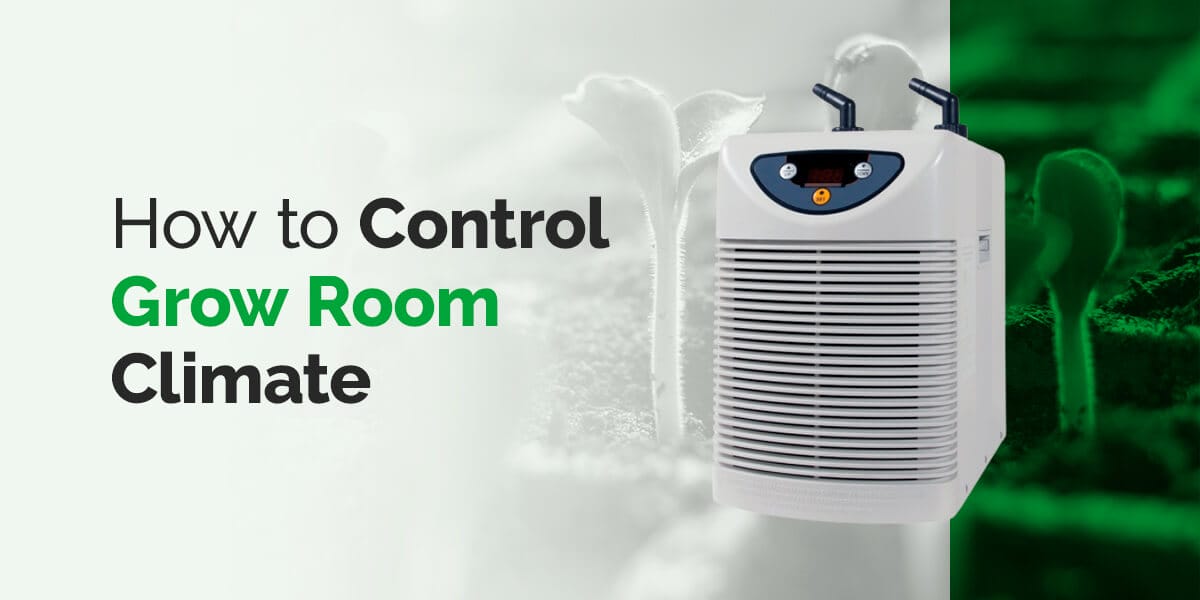If you grow indoors you know space is often one of the most limiting factors determining what and how you grow. Every indoor grower wants to maximize production, but getting more isn’t always about growing bigger plants. Learning how to make the most efficient use of space in your grow room can also pay off handsomely. In this segment, we’ll discuss some tricks and techniques that will help you more out of the space you have to work with. Plus, cash in on our featured coupon code to save on gear that will help you get the job done!
Planning Your Planting

Before pushing the capacity limits of your indoor garden, you want to figure out the standard space needs of your plants, in other words, you need to know how big your plants get when growing naturally. A common mistake a lot of indoor growers make when trying to get more out of their space is just cramming plants in their grow tents or grow rooms, which can easily lead to problems with disease and slow plant growth. The best approach is to run a test grow with a single plant, or fewer than you think will fit, the first few times you grow in your space. Once you know how big your plants will normally get, you will have a better idea of how many plants you can start with before and which methods below will help you produce more plant growth in your grow space. Remember, it’s always better to have too much space for your plants rather than too little!
Continuous Harvest Growing
When planning you should decide if you are going to try to have plants flowering or fruiting all the time, or if you want to have a single generation of plants that you start as seeds or clones and allow them to flower together and then start over (intermittent harvest). With a continuous harvest, you will be constantly starting seeds or you could also consider the option of having a mother plant where you will constantly take cuttings. In either case, you will need to have separate growing areas. Plants have very different needs at different points of their lives, so creating a space that caters to all those needs isn’t as efficient as creating different areas for the different needs.
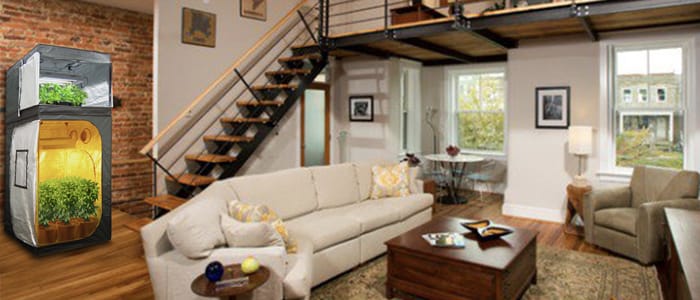
Multi-Chamber Grow Rooms – If you can’t have two completely separate growing areas, one space-saving technique for continuous-harvest growing is to have separate chambers in the grow area for the vegetative and bloom phases of growth. A common multi-chamber technique is to have a smaller space lit with T5 grow lights or LED grow lights and a larger chamber with a something along the lines of a ceramic metal halide or HPS grow light. The smaller chamber is used for seed starting and early vegetative growth. When it’s time to flower the plants are moved to the larger chamber to complete the growth cycle. Light cycles are one of the most important things to consider when creating separate chambers in the grow space. Each chamber should be lightproof to prevent one light cycle from interfering with the other. Each chamber should also be ventilated properly in order to avoid temperature and humidity issues. Where possible, separating vegetative and flowering areas allows for a very efficient use of growing space and the plants are able to grow quickly and healthily.
Equipment Placement
You will need to have more than just plants and a light in your grow area. For example, you may want to supplement your plants with CO2 and all growers should be monitoring the temperature and humidity throughout their grow room. As was mentioned, depending on where in your house you are growing, you may need to deal with heat, humidity or cold and will use various pieces of equipment to do this. However, not all equipment has to take up floor space your plants need – especially in grow tents, there are many options for growers looking to capitalize on every square inch of their setup. It is a common practice to hang grow lights from the ceiling of grow tents or rooms, but other equipment like circulation fans and grow room controllers can be kept high up and out of the way of your plants too by using space-saving tools such as grow tent equipment racks. Keeping grow room ventilation equipment tight to the top of the space as seen in the image below will also open up space and improve ventilation. Of course, hanging isn’t an option for things like heaters, A/C, or CO2 tanks though so this type of equipment should be located outside of the growing area and ducted/piped in to open up space.
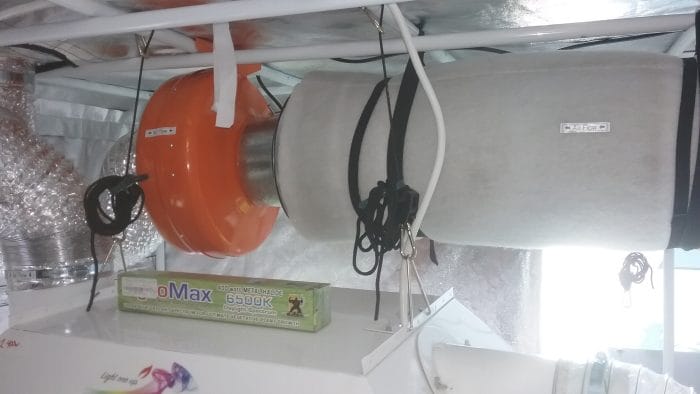
Pro Tip: CO2 sinks because it’s heavier than the surrounding air so you should be introducing/dispersing it at the top of your grow area or above your plants!
Space Maximizing Plant Containers
When growing in a small space, the use of the right container will allow you to grow plants to the size and shape you want. Smaller containers mean less root growth which typically means smaller plants. When roots can’t continue to grow, plants become stunted and won’t grow or flower properly so it is in your best interest to have roots growing throughout the entire growth cycle. However, there is a simple way to get increased plant growth with smaller containers.

Air-pruning containers like airpots and smart pots let your plants’ roots continuously shape themselves without becoming tangled and knotted. Here’s what we mean: in a typical plastic container, the roots spread outward until they hit the side of the container, at which point they grow down. Once they reach the bottom, they grow sideways around the edge of the pot until the root mass eventually resembles a big circle. The resulting root ball that forms is inefficient and will result in a stunted plant. However, in airpots and fabric grow pots, the roots are able to slightly poke through the surface of the pot. When this happens, the tip of the root dies off as it grows out into the air. The root in the container branches out in several directions rather than just moving downward. The end result is a container with much better root distribution, leading to a much larger and healthier plant relative to the container size. Smaller air-pruning containers, open up the possibility of growing more plants in a given space or simply fitting them in a smaller space to begin with.
Planting Orientation and Plant Training
Utilizing the right equipment and placing it properly will definitely help you maximize use of grow room space, but in terms of saving space, there are also some planting methods and techniques you can use to achieve spacial efficiency. You can grow plants in levels vertically, you can train them to grow on a trellis, you can prune them or bend them and you can even try to grow them on their side.
Vertical Gardening Space – Making use of the vertical room in your garden can be a great way to get more out of your space. This planting technique will work well for smaller flowering plants, herbs, and leafy greens and can easily be done utilizing stacked shelving and low-heat light sources like T5 grow lights or full spectrum LED grow strip lights. These types of lights offer a low profile and mount easily under shelving to allow the most remaining room for plant growth. Use of vertical space can also be accomplished using ‘garden towers’ in which a column-like container with holes in the sides is either filled with soil or fitted with a hydroponic drip type system. Plants are grown out of the holes, and the whole thing only takes up the amount of space needed for the tower. In most cases, vertical lighting with T5 grow lightsor LED’s will be used in conjunction with the tower. Maximizing use of your vertical space can keep your plants contained to a smaller floor space without sacrificing the number of plants you want to grow!
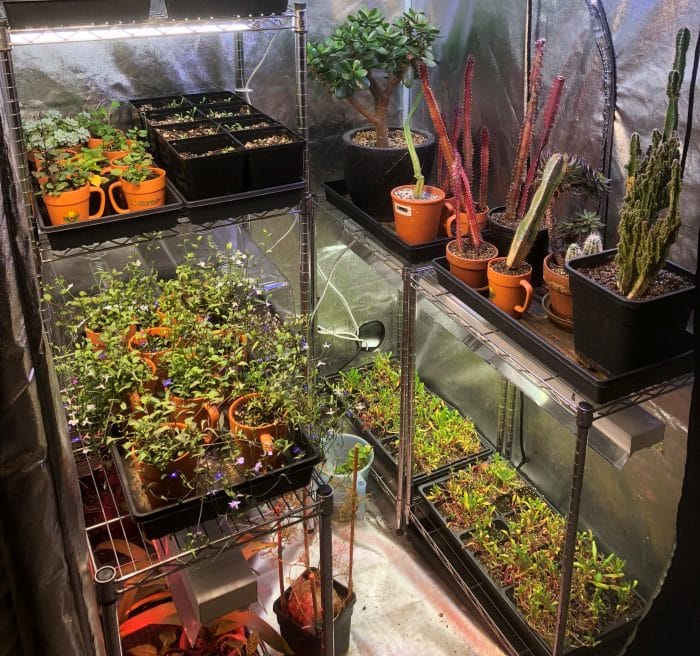
Growing Sideways – If you only have an area with a low ceiling, or have to grow in a restricted area you could try growing your plants on their side. To do this you simply start the plants as usual, and when they get a foot tall, or however tall until they are too close to the light you will place the plant/ container on their side with a tray underneath. Plant tops and branches always grow away from gravity, so the plant will grow up. You can then try to prune or bend the top and branches to keep them low and away from the light. Many growers that use this technique will put holes on the sides of the nursery pots to make watering easier. If you are using cloth containers or Oxypot type containers, you will be able to just water the side of the container, make sure you have a tray big enough to catch the water under the pot.
Pruning & Plant Bending
Keeping your plants contained within defined boundaries is crucial to setups with very limited space so another option is to manipulate the growth patterns of your plant, which can offer more efficient use of the space.
Pruning Techniques – Pruning is often used to refine the appearance of showy plants like roses or nursery trees, but it can be used to affect the growth of any plant. The top of plants where new growth occurs is called the apical meristem and the ends of branches where new growth occurs are called lateral meristems. These meristems (where new growth occurs) secretes hormones that affect plant growth. If you cut off the apical meristem the plant will become bushier as the branches grow. Cutting the lateral meristems will stop a branch from growing and may encourage each branch to divide and branch more. If you are trying to get your plants to grow into a specific space, removing branches from one side of a plant encourages those on the other sides to grow larger, and removing branches from the bottom of the plant can encourage the flowering top of the plant to grow better. By pruning your plants with a specific shape in mind, you can force your plant to grow into the space it needs to occupy.

Pro tip: You should not prune your plants until they are vigorously growing and have several sets of leaves. Pruning small immature plants can result in stunted growth.
Bending – Another technique that’s used alongside pruning is “bending” the plant. Many growers employ the use of stakes and ties to limit the sideways growth of a plant. If you bend the top of a plant or branch over, the hormones will not travel around and like with pruning this will encourage your plants to grow bushier and be shorter. You can use ties specifically for bending plants, or anything that is not too thin so that it will cut into the plant stem. When you bend the top of the plant or branches you’re not trying to fold it in half, which might cause the stem to break or kink. Bend the top or branch about 90 degrees to allow it to continue growing. You can keep bending the new growth to keep your plant at a certain height or to encourage it too grow into the space you have. This can be a good technique to use in setups where one or several of your plants overshadow the others. By forcing your plant to grow more sideways, by bending them away from each other you give the other plants time to catch up rather than allowing one plant to shade the other plants. Keeping a consistent height among your plants leads to even growth and an overall increase in the effectiveness of your space.
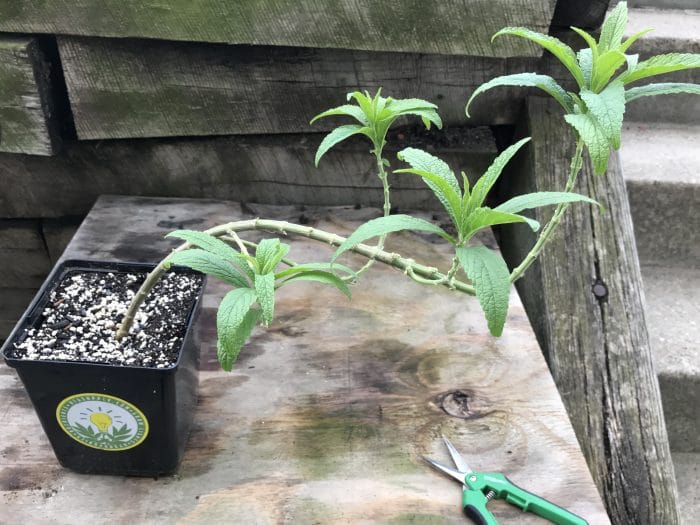
Using Plant Trellis or Screen – One of the most utilized methods for maximizing space with certain plants is the Screen of Green (ScrOG) method. In a ScrOG setup, garden trellis netting is suspended horizontally about halfway between the surface of your grow medium and your lights. As your plants grow, their tops and branches need to be trained along netting or fence to encourage them to grow horizontally taking up the entire area of the screen. You will encourage the plant(s) to grow horizontally along the netting instead of vertically toward the light. When it is time to flower you allow each branch or sub-branch to develop into a new vertical “stalk” which will allow you to maximize the grow space under the light and creates more tops on your plants. This is especially effective in larger setups where a few plants can be forced to spread out and then up, creating the same harvest as if you had many more plants.
Overcrowding
Now, after talking about freeing up all this space for our plants, it’s especially important to mention that it’s possible to put too many plants in one spot. This is known as “overcrowding” and it can lead to more complications with your plant’s growth. For one, the amount of light received by each plant can be severely lessened when an adjacent plant grows large enough to block out the light. If your plants’ leaves are covering each other, neither plant will get enough light and neither plant will grow at its maximum rate. There is a point where you will actually get lower yields with more plants since none of the plants get enough light. Similarly, if you put multiple plants in one container, (which is not recommended usually) it’s possible for one plant’s root zone to ‘choke out’ that of another plant. Your plants all need space, to get light and for gas exchange (CO2) and there is only so much in your grow area. You want to grow enough plants so that they get all the light and CO2 they need and are not limited by competition with one another.
To sum it up – every indoor garden has its limits, but there really is no hard and fast rule as to how many plants you can grow in a given space or how much you can harvest from it. When it comes to maximizing use of space in your grow room, the biggest obstacles you’ll face won’t be cost, labor, or even time. Actually, the hardest part is just figuring out what method or methods you want to use.
____________________
Tips or tricks of your own to share? Join the conversation, and comment below! Throw a picture on Instagram and tag us in it (@HTGSupply) – we’d love to see your results! Don’t forget to check out this week’s coupon code and sale information as well! From all of us here, good luck, stay safe, and Happy Growing!
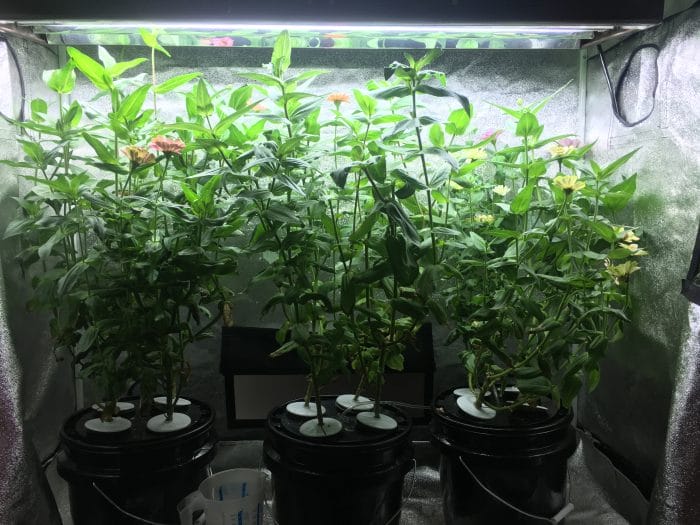
THIS WEEK’S COUPON CODE: SPACE518
Enter the promo code at checkout for a 20% discount on select accessories including the products featured below! Visit your local HTG Supply and simply mention this article to get the deal in-store as well! Thanks again for tuning into Talking Shop with HTG Supply! Offer valid through HTGSupply.com and in-store 05/04/18-05/19/18. Cannot be combined with other offers. Follow us on social media for all the Sales, Events and Customer Appreciation Days. In addition, learn more about indoor growing and get all kinds of tips, tricks and techniques!
By: HTG Supply on 05/07/2018
